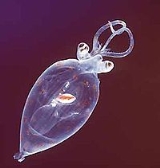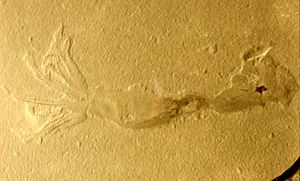
Coleoidea
Encyclopedia
Subclass Coleoidea, or Dibranchiata, is the grouping of cephalopod
s containing all the primarily soft-bodied creatures
. Unlike its sister group Nautiloidea, whose members have a rigid outer shell for protection, the coleoids have at most an internal bone or shell that is used for buoyancy or support. Some species have lost their bone altogether, while in some it has been replaced by a cartilaginous
support structure.
The major dividings of Coleoidea are based upon the number of arms
or tentacle
s and their structure. The extinct and most primitive form, the Belemnoidea
, presumably had ten equally sized arms, in five pairs numbered dorsal
to ventral as I, II, III, IV and V. More modern species either modified or lost a pair of arms. The superorder Decapodiformes
has arm pair IV modified into long tentacles with suckers generally only on the club-shaped distal end. Superorder Octopodiformes
has modifications to arm pair II; it is significantly reduced and used only as a sensory filament in the Vampyromorphida
, while Octopoda species have totally lost that arm pair.
Period, about 330 million years ago. Some older fossils have been described from the Devonian
,
but paleontologists disagree about whether they are coleoids.
By the Carboniferous, coleoids already had a diversity of forms. Although most of these groups are traditionally classified as belemnoids, the variation among them suggests that some are not closely related to belemnites.

Cephalopod
A cephalopod is any member of the molluscan class Cephalopoda . These exclusively marine animals are characterized by bilateral body symmetry, a prominent head, and a set of arms or tentacles modified from the primitive molluscan foot...
s containing all the primarily soft-bodied creatures
Soft-bodied organisms
The term "soft-bodied organism" is used to describe animals without skeleton, roughly corresponding to the group Vermes as proposed by Carl von Linné. All animals have muscles, but since muscles can only pull, never push, a number of animals have developed hard parts that the muscles can pull on,...
. Unlike its sister group Nautiloidea, whose members have a rigid outer shell for protection, the coleoids have at most an internal bone or shell that is used for buoyancy or support. Some species have lost their bone altogether, while in some it has been replaced by a cartilaginous
Cartilage
Cartilage is a flexible connective tissue found in many areas in the bodies of humans and other animals, including the joints between bones, the rib cage, the ear, the nose, the elbow, the knee, the ankle, the bronchial tubes and the intervertebral discs...
support structure.
The major dividings of Coleoidea are based upon the number of arms
Cephalopod arm
A cephalopod arm is distinct from a tentacle, though the terms are often used interchangeably.Generally, cephalopod arms have suckers along most of their length, as opposed to tentacles, which have suckers only near their ends. Octopuses have eight arms and no tentacles, while squid and cuttlefish...
or tentacle
Tentacle
A tentacle or bothrium is one of usually two or more elongated flexible organs present in animals, especially invertebrates. The term may also refer to the hairs of the leaves of some insectivorous plants. Usually, tentacles are used for feeding, feeling and grasping. Anatomically, they work like...
s and their structure. The extinct and most primitive form, the Belemnoidea
Belemnoidea
Belemnoids are an extinct group of marine cephalopod, very similar in many ways to the modern squid and closely related to the modern cuttlefish. Like them, the belemnoids possessed an ink sac, but, unlike the squid, they possessed ten arms of roughly equal length, and no tentacles...
, presumably had ten equally sized arms, in five pairs numbered dorsal
Dorsum (biology)
In anatomy, the dorsum is the upper side of animals that typically run, fly, or swim in a horizontal position, and the back side of animals that walk upright. In vertebrates the dorsum contains the backbone. The term dorsal refers to anatomical structures that are either situated toward or grow...
to ventral as I, II, III, IV and V. More modern species either modified or lost a pair of arms. The superorder Decapodiformes
Decapodiformes
Decapodiformes is a superorder of Cephalopoda, which includes all species with ten limbs; the name derives from the Greek word meaning ten feet. The ten limbs are divided into 8 short arms and 2 long tentacles. It is presumed that an ancestral coleoid had five identical pairs of limbs, and that one...
has arm pair IV modified into long tentacles with suckers generally only on the club-shaped distal end. Superorder Octopodiformes
Octopodiformes
Octopodiformes is a superorder of the subclass Coleoidea. It comprises the octopuses and the vampire squid. All members of Octopodiformes have 8 arms.-Classification:*Class Cephalopoda**Subclass Nautiloidea: nautilus**Subclass †Ammonoidea: ammonites...
has modifications to arm pair II; it is significantly reduced and used only as a sensory filament in the Vampyromorphida
Vampyromorphida
Vampyromorphida is an order of cephalopods comprising one known extant species and many extinct taxa. Physically, they somewhat resemble octopuses, but the eight main tentacles are united by a web of skin, and two smaller tentacles are also present.-Classification:*Order Vampyromorphida**?Suborder...
, while Octopoda species have totally lost that arm pair.
Evolutionary history
The earliest certain coleoids are known from the Mississippian sub-period of the CarboniferousCarboniferous
The Carboniferous is a geologic period and system that extends from the end of the Devonian Period, about 359.2 ± 2.5 Mya , to the beginning of the Permian Period, about 299.0 ± 0.8 Mya . The name is derived from the Latin word for coal, carbo. Carboniferous means "coal-bearing"...
Period, about 330 million years ago. Some older fossils have been described from the Devonian
Devonian
The Devonian is a geologic period and system of the Paleozoic Era spanning from the end of the Silurian Period, about 416.0 ± 2.8 Mya , to the beginning of the Carboniferous Period, about 359.2 ± 2.5 Mya...
,
but paleontologists disagree about whether they are coleoids.
By the Carboniferous, coleoids already had a diversity of forms. Although most of these groups are traditionally classified as belemnoids, the variation among them suggests that some are not closely related to belemnites.
Classification

- Class CephalopodaCephalopodA cephalopod is any member of the molluscan class Cephalopoda . These exclusively marine animals are characterized by bilateral body symmetry, a prominent head, and a set of arms or tentacles modified from the primitive molluscan foot...
- Subclass Nautiloidea: nautilus
- Subclass †Ammonoidea: ammonites
- Subclass Coleoidea
- Division †BelemnoideaBelemnoideaBelemnoids are an extinct group of marine cephalopod, very similar in many ways to the modern squid and closely related to the modern cuttlefish. Like them, the belemnoids possessed an ink sac, but, unlike the squid, they possessed ten arms of roughly equal length, and no tentacles...
: extinct belemnoids- Genus †JeletzkyaJeletzkyaJeletzkya is a fossil coleoid from the early Pennsylvanian Mazon Creek lagerstätten and represents the earliest known crown-group squid. Non-mineralized anatomy is preserved and comprises ten hooked tentacles and a radula....
- Order †HematitidaHematitidaHematitida is a group of coleoid cephalopods known from the early Carboniferous Period. They are the oldest definite coleoids, although there are controversial claims for even older coleoids from the Devonian. Fossil hematitidans have so far been found only in Arkansas and Utah of the USA...
- Order †PhragmoteuthidaPhragmoteuthidaPhragmoteuthida is an order of coleoid cephalopods.-Classification:* Order Phragmoteuthida**Family Phragmoteuthididae***Genus Permoteuthis***Genus Phragmoteuthis***"unnamed form"**Family Rhiphaeoteuthidae***Genus Rhiphaeoteuthis...
- Order †Donovaniconida
- Order †AulacoceridaAulacoceridaAulacocerida is an extinct order of belemnoids....
- Order †BelemnitidaBelemnitidaBelemnitida is an extinct order of cephalopods which existed during the Mesozoic era, from the Hettangian age of the Lower Jurassic to the Maastrichtian age of the Upper Cretaceous.-Description:...
- Genus †Jeletzkya
- Division NeocoleoideaNeocoleoideaNeocoleoidea is a large group of marine cephalopods. This cohort contains two extant groups: Decapodiformes and Octopodiformes . Species within this group exist in all major habitats in the ocean, in both the southern and northern polar regions, and from intertidal zones to great depths...
- Superorder DecapodiformesDecapodiformesDecapodiformes is a superorder of Cephalopoda, which includes all species with ten limbs; the name derives from the Greek word meaning ten feet. The ten limbs are divided into 8 short arms and 2 long tentacles. It is presumed that an ancestral coleoid had five identical pairs of limbs, and that one...
- ?Order †BoletzkyidaBoletzkyidaThe Boletzkyda are perhaps the very earliest of the teuthid coleoid cephalopods, which seem to form a link between nautiloid orthocerids and more advanced coleoids. The Beletzkyda was named and described by Bandel, Reitner, and Sturmer in 1983 from specimens found the Lower Devonian black slate...
- Order SpirulidaSpirulidaSpirulida is an order of cephalopods comprising one extant species and several extinct taxa.-Classification:*Order Spirulida**?Family Shimanskyidae**Suborder †Groenlandibelina***Family †Groenlandibelidae...
: Ram's Horn Squid - Order Sepiida: cuttlefish
- Order Sepiolida: bobtail squid
- Order Teuthida: squid
- ?Order †Boletzkyida
- Superorder OctopodiformesOctopodiformesOctopodiformes is a superorder of the subclass Coleoidea. It comprises the octopuses and the vampire squid. All members of Octopodiformes have 8 arms.-Classification:*Class Cephalopoda**Subclass Nautiloidea: nautilus**Subclass †Ammonoidea: ammonites...
- Family †Trachyteuthididae (incertae sedisIncertae sedis, is a term used to define a taxonomic group where its broader relationships are unknown or undefined. Uncertainty at specific taxonomic levels is attributed by , , and similar terms.-Examples:*The fossil plant Paradinandra suecica could not be assigned to any...
) - Order VampyromorphidaVampyromorphidaVampyromorphida is an order of cephalopods comprising one known extant species and many extinct taxa. Physically, they somewhat resemble octopuses, but the eight main tentacles are united by a web of skin, and two smaller tentacles are also present.-Classification:*Order Vampyromorphida**?Suborder...
: Vampire Squid - Order Octopoda: octopus
- Family †Trachyteuthididae (incertae sedis
- Superorder Decapodiformes
- Division †Belemnoidea
- (uncertain order)
- family †OstenoteuthidaeOstenoteuthidaeOstenoteuthidae is an extinct family of cephalopods from Lower Jurassic of Italy. They have ten arms with unusual structure.Both known species are from Lower Sinemurian....
- family †Ostenoteuthidae

